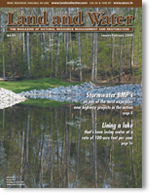Features Available Online
Plum Creek Wetlands Restoration
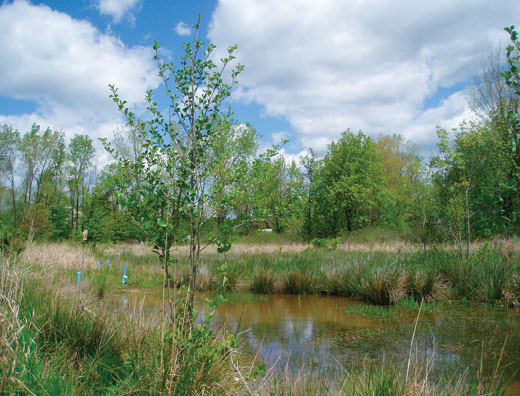
In May 2008, the Plum Creek Wetlands Restoration Site was a mix of seasonally inundated areas, emergent marsh plants and developing wooded communities.
The Plum Creek Wetlands Mitigation Site, previously a fallow agricultural field, is now more than five acres of restored wetlands. Created to mitigate wetlands lost by the construction of a commercial development known as Brunswick Town Center, the site is located within and managed by the Medina (Ohio) County Park District.
As the site nears the end of the required five-year monitoring period, the project managers at Davey Resource Group, a division of The Davey Tree Expert Company, are able to draw conclusions about the challenges faced and solutions arrived at during the project’s life.
Project Background
When Zaremba Group began development of what was to become Brunswick Town Center, it was apparent that wetlands disturbed by the project would need to be mitigated by restoration of wetlands elsewhere in the watershed. Zaremba looked to Davey to assist in obtain the necessary 401/404 permits and to identify an appropriate site for the restoration effort. They were contracted to draft a plan, direct construction, manage planting, control invasive species, and conduct monitoring at the Plum Creek site.
In 2003 a Wetlands Mitigation and Monitoring Plan was prepared. The plan called for the creation of 3.5 acres of shallow, seasonally inundated meadow that would evolve into wooded and scrub/shrub wetlands as the system matures. It included provisions to plant herbaceous and woody hydrophytic vegetation and by seed collected from existing wooded wetlands adjacent to the site.
Once both Ohio EPA and U.S. Army Corps of Engineers approved it, the work began on the site in an undeveloped portion of Plum Creek Park.
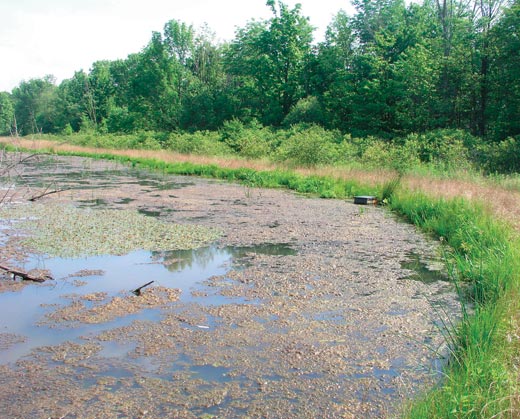
A berm constructed along the eastern edge of the project area may be used in the future for a walking trail.
The Site
The Plum Creek Wetlands Mitigation Site is located in Brunswick Hills Township, Medina County, Ohio. Although the site receives ample surface runoff, stormwater runoff from an adjacent development is partially directed to the site, creating a watershed of approximately 8.4 acres that drains into the restored wetlands. The site eventually drains into Plum Creek to the east.
The soils in the poorly drained area of upland fields with shrubby secondary growth were found to be suitable to support wetland conditions. Clay drainage tiles identified during the pre-construction period suggest previous attempts to manage the water from a spring in the area. Once the tiles were disrupted the wetland hydrology was restored.
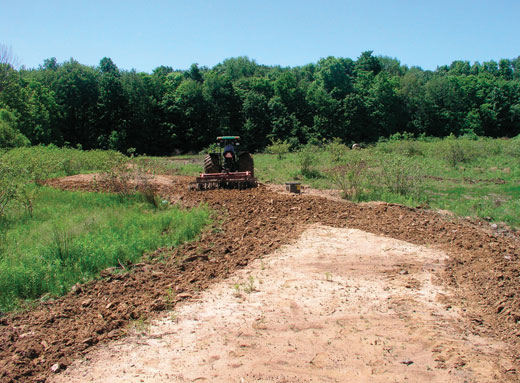
Disking the site made the compacted soils more receptive to cultivation of the wetlands seed mix and created microtopography throughout the mitigation area. In addition, the disking of the site effectively cut existing shrubs, such as silky dogwood and willow, which provided for the cuttings to be dispersed and repopulate elsewhere on the site.
Project Objectives
The success of the project can be ascertained by several specific measurements. By the end of the fifth year following construction, the project should have restored 3.5 acres of wetlands, achieved a vegetation index of biotic integrity of 44-65, have less than 5 percent invasive species, met 80 percent of hydrophytic vegetation cover and mortality rates ranging from of 5 to 15 percent for buttonbush (Cephalanthus occidentalis), speckled alder (Alnus rugosa), swamp white oak (Quercus bicolor) and black gum (Nyssa sylvatica) planted as bare root or container grown stock.
While the five-year monitoring period is still a few months short of complete, the project appears to be on target for each of the following specific goals:
- The seasonally inundated area has achieved a variety of water depths from saturated soil to 1-3 feet of standing water during spring and summer.
- Hydric soil conditions are present throughout the site.
- Wet meadow vegetation has established throughout the site with the presence of 91 different species of wetlands plants. The wet meadows will develop into a mosaic of forested wetlands and buttonbush swamps to replace habitat types impacted by the development at Brunswick Town Center.
- A total of 6.1 acres of wetlands have established on the site, far in excess of the 3.5 required to be restored.
Implementation
In late 2003, working under the supervision of Davey project manager Ken Christensen, Marks Construction Company created berms and pools, relocated topsoil, dug trenches and roughed the surface to create an undulating landscape. During the process of sculpting the terrain, desirable plant materials and soils were temporarily relocated to be returned later.
According to Christensen, the earth sculpting was a “design/build” process. “Although we had a general plan for construction, when we saw plants that we wanted to save, we redirected the bulldozer on the spot”. He added that the flexibility of Marks employees made it easy to make those requests as the work on the site progressed.
Mark Szakacs, president of Marks Construction Company, remarked on the creativity allowed by the project. “We’ve worked with Davey on several wetlands projects and in each case, they typically show us the general location for berms and overflows, and we are able to make suggestions for things such as good borrow areas.”
The final configuration of topsoil created low-lying areas between berms that will impound and redirect water flow. A berm along the eastern border of the property was equipped with three water level control structures to allow the manipulation of water levels by park staff. It was constructed to accommodate a trail at some future date. To disable subsurface tile systems and retain water within the wetlands restoration site, a four-foot deep trench bisected the area. This trench was subsequently filled and compacted. The movement of heavy equipment created ruts and gouges in the area to disrupt drainage.
Following the earthwork, the wetland area was seeded with mixes containing more than 75 native obligate and facultative wetlands seeds and the berms were seeded with a native upland mix.
Trees and shrubs, including speckled alder (Alnus rugosa), swamp white oak (Quercus bicolor) and black gum (Nyssa sylvatica) were planted throughout the site. Buttonbush (Cephalanthus occidentalis), was planted in the restored wetland pool areas with the suitable hydrology. An eastern white pine (Pinus strobus) that had been identified and relocated early in the construction phase was reinstalled on a newly created upland knoll. The pine, which was the subject of its own adventure, had been removed from the site by an unknown person. It was returned when Davey staffers followed the drag trail and recovered the tree.
Low mortality rates for trees and shrubs is one criterion that must be satisfied by the end of the monitoring period, and appears to have been met as the monitoring heads into its final months.
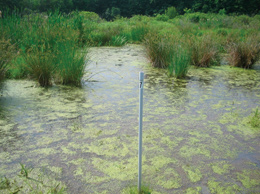
Stakes, whose locations were also identified by GPS coordinates, identified zones so that the progress of the restoration area could be monitored during the five year period that followed construction.
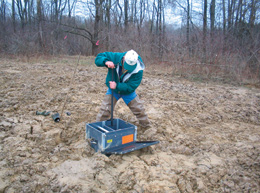
Agri Drain Inline Water Level Control Structures™ installed in the project area will allow Park District scientists to manage water depths and duration.
Monitoring Phase
The five-year monitoring required by federal and state regulations is to insure that the goals established in the mitigation plan are met or developing appropriately.
Scientists can document the movement toward achieving the mitigation goals by looking at plant composition and cover, soil inundation and saturation, water quality and wildlife use. Eight quadrants were established within the site and identified with PVC stakes and GPS reference points. At the end of the fourth monitoring year, each of the eight quadrants of the property met jurisdictional wetlands criteria including water depth, soil composition, diversity of plant types, and absence of invasive species.
The five benchmarks that were to be met by the end of the monitoring period are well on the way to being satisfied. And, although it is not one of the project goals, the increase in vegetation diversity and cover created significant habitat for wetlands dependent birds, mammals, amphibians, and reptiles.
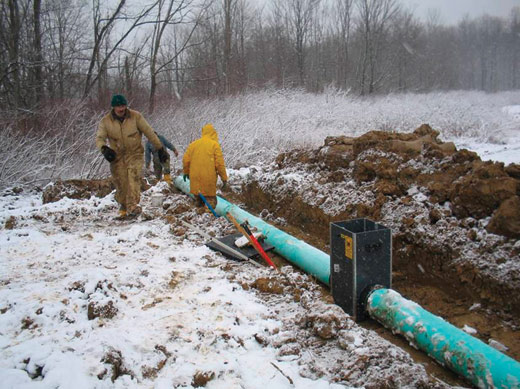
Future management of water in the restoration area will be facilitated by the drainage system installed during the construction phase.
During the monitoring period, Davey treated invasive species such as reed canary grass (Phalaris arundinacea) with a broad-spectrum glyphosate herbicide. As the invasive species on the site were eradicated, scientists that specialize in invasive plant management were able to note an increased number of native plant species, a trend that is expected to continue. Improved hydrology in the site has expanded the wetlands significantly in the north and west of the site.
By summer 2008, the project encompassed 6.1 acres of restored wetlands, representing a surplus acreage of 2.6 acres from the original acreage goal. Project managers point to the surplus as an indication of the success of the mitigation and the general unpredictability in restoring a wetland habitat.
As the monitoring phase comes to an end, the Davey staff is evaluating its role in the project. The initial planning document served as a map, but site conditions dictated changes once construction began. The flexibility of the construction crews gave the on-site manager the ability to evaluate conditions on the ground and alter direction accordingly. Budgeting for the project was also an opportunity for estimating the inestimable as each mitigation project brings unique conditions to the fore.
| The initial planning document served as a map, but site conditions dictated changes once construction began. The flexibility of the construction crews gave the on-site manager the ability to evaluate conditions on the ground and alter direction accordingly. |
Looking Forward
Because the Plum Creek Park is owned and managed by the Medina County Park District, the ongoing care of the site will fall to its biologists. There is a potential for a trail along an eastern berm within the site, and the park would also like to incorporate interpretative signs and educational programs at the park. But the Park District will also need to be vigilant against invasions by non-native species and monitor against disruptions in the return to wetlands condition.
Thomas James, director of the Medina County Park District views the mitigation site at Plum Creek Park as part of the on-going program to recreate valuable habitats with in the system. “Wetland restoration projects create area, which enhance the ability of our staff to teach the public about the benefits of wetlands,” he said. “It also creates unique areas along our hiking trials for the public to view and enjoy.” ![]()
For more information, contact Ken Christensen, Davey Resource Group, a division of The Davey Tree Expert Company, (800)828-8312, ext. 34.

